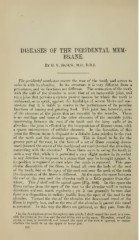Page 908 - My FlipBook
P. 908
DISEASES OF THE PERIDENTAL MEM-
BRANE.
By G. V. BLACK, M.D., D.D.S.
The peridental membrane covers the root of the tooth and serves to
unite it with its alveolus. In its structure it is very diiferent from a
periosteum, and its functions are diiferent. The connection of the tooth
with the wall of the alveolus is more that of an immovable joint, and
yet a joint that permits a certain passive motion by which the tooth is
cushioned, so to speak, against the hardships of severe blows and con-
cussions that it is liable to receive in the performance of its peculiar
functions of tearing and grinding food. This joint has, however, none
of the elements of tjie joints that are movable by the muscles. There
is no cartilage and none of the other elements of the movable joints
intervening between the root of the tooth and the bony walls of its
alveolus : the joint is effected by the interposition of fibrous tissue, with
a sparse intermixture of cellular elements. In the formation of this
joint the fibrous tissue is disposed in a definite form relative to the root
of the tooth and the alveolar process. This is found to be, for the
grejiter part of the root, in the form of a set of fibres running down-
ward (toward the crown of the tooth) and outward (toward the alveolus),
connecting with the alveolus.^ These fibres serve to swing the tooth in
such a way that, while it is permitted a very slight motion in its socket
in any direction in response to a strain that may be brought against it,
its position is regained at once when the strain is removed. This par-
ticular disposition of the fibres is found all over the body of the root
of the tooth, but on the apex of the root and near the neck of the tooth
the disposition of the fibres is diiferent. At the apex the space between
the end of the root and the alveolar wall is a little greater than else-
where. This I shall call the apical space (Fig. 484). In this space the
fibres radiate from the apex of the root to the alveolar wall in various
directions without much regularity it can generally be seen that
; yet
tiiere is a disposition to radiate fanlike from the apex of the root to the
alveolus. Toward the rim of the alveolus the downward trend of the
fibres is rapidly lost, and as the rim of the alveolus is passed this trend
is reversed. In this way the fibres are gathered, as they pass from the
^ In tlie descriptions given thronghont this article I sliall regard the tooth as a cone,
with the crown as the base and the end of tlie root as tlie apex. Therefore, toward the
crown, or hase, is downward, and toward the apex of the root is upward, no matter
whether the tooth be in tlie upper or lower jaw.
918


